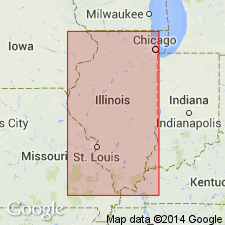
- Usage in publication:
-
- New London Member
- Modifications:
-
- Original reference
- Dominant lithology:
-
- Calcarenite
- Limestone
- AAPG geologic province:
-
- Lincoln anticline
- Illinois basin
Summary:
Pg. 125, 239. New London Member of Dunleith Formation. Present in northeastern Missouri and western Illinois. Fine- to medium-grained calcarenite and fine-grained to lithographic, calcarenitic limestone in medium beds, moderately pure, mostly cherty, with some thin argillaceous and weakly shaly beds. Entire member present only in extreme northern part of southern outcrop area where it is 35 to 45 feet thick; about 32 feet at type section where it overlies Moredock Member (new) and underlies Wise Lake Formation. South of Calhoun County, western Illinois, is overlapped by Cape Limestone and Elgin Shale of Maquoketa Group. It is a previously undifferentiated part of Kimmswick Limestone and appears to be essentially equivalent to middle cherty member of Kimmswick (McQueen and Greene, 1938, Missouri Geol. Survey Water Res., 2d ser., v. 25), which is 55 feet thick in northwestern Missouri. Equivalent to Sherwood, Wall, and Wyota Members by northern outcrop area. Age is Middle Ordovician (Champlainian).
Type section: roadcut of U.S. Highway 61 in north side of Salt Creek, 2 mi north of New London, Ralls Co., northeastern MO, in NE/4 SW/4 sec. 25, T. 56 N., R. 5 W., Hannibal quadrangle.
Source: US geologic names lexicon (USGS Bull. 1350, p. 526).
For more information, please contact Nancy Stamm, Geologic Names Committee Secretary.
Asterisk (*) indicates published by U.S. Geological Survey authors.
"No current usage" (†) implies that a name has been abandoned or has fallen into disuse. Former usage and, if known, replacement name given in parentheses ( ).
Slash (/) indicates name conflicts with nomenclatural guidelines (CSN, 1933; ACSN, 1961, 1970; NACSN, 1983, 2005, 2021). May be explained within brackets ([ ]).

